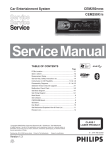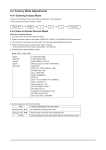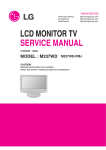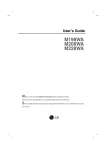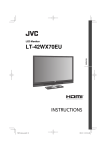Download COLOR MONITOR SERVICE MANUAL
Transcript
Website:http://biz.LGservice.com E-mail:http://www.LGEservice.com/techsup.html COLOR MONITOR SERVICE MANUAL CHASSIS NO. : LP69G MODEL: M208WA (M208WA-BZH.A**VLP) *( ) **Same model for Service CAUTION BEFORE SERVICING THE UNIT, READ THE SAFETY PRECAUTIONS IN THIS MANUAL. CONTENTS CONTENTS .............................................................................................. 2 PRECAUTION ...........................................................................................3 SPECIFICATION ........................................................................................7 DISASSEMBLY ........................................................................................13 ADJUSTMENT ........................................................................................15 SERVICE OSD .........................................................................................21 TROUBLE SHOOTING ............................................................................22 BLOCK DIAGRAM...................................................................................28 EXPLODED VIEW ...................................................................................31 REPLACEMENT PARTS LIST ............................................................... 33 SVC. SHEET ............................................................................................... -2- PRECAUTION WARNING FOR THE SAFETY-RELATED COMPONENT. WARNING • There are some special components used in LCD monitor that are important for safety. These parts are marked on the schematic diagram and the replacement parts list. It is essential that these critical parts should be replaced with the manufacturer’s specified parts to prevent electric shock, fire or other hazard. • Do not modify original design without obtaining written permission from manufacturer or you will void the original parts and labor guarantee. BE CAREFUL ELECTRIC SHOCK ! • If you want to replace with the new backlight (CCFL) or inverter circuit, must disconnect the AC adapter because high voltage appears at inverter circuit about 650Vrms. • Handle with care wires or connectors of the inverter circuit. If the wires are pressed cause short and may burn or take fire. Leakage Current Hot Check Circuit TAKE CARE DURING HANDLING THE LCD MODULE WITH BACKLIGHT UNIT. AC Volt-meter • Must mount the module using mounting holes arranged in four corners. • Do not press on the panel, edge of the frame strongly or electric shock as this will result in damage to the screen. • Do not scratch or press on the panel with any sharp objects, such as pencil or pen as this may result in damage to the panel. • Protect the module from the ESD as it may damage the electronic circuit (C-MOS). • Make certain that treatment person’s body are grounded through wrist band. • Do not leave the module in high temperature and in areas of high humidity for a long time. • The module not be exposed to the direct sunlight. • Avoid contact with water as it may a short circuit within the module. • If the surface of panel become dirty, please wipe it off with a softmaterial. (Cleaning with a dirty or rough cloth may damage the panel.) CAUTION Please use only a plastic screwdriver to protect yourself from shock hazard during service operation. -3- Good Earth Ground such as WATER PIPE, CONDUIT etc. To Instrument's exposed METALLIC PARTS 1.5 Kohm/10W SERVICING PRECAUTIONS CAUTION: Before servicing receivers covered by this service manual and its supplements and addenda, read and follow the SAFETY PRECAUTIONS on page 3 of this publication. NOTE: If unforeseen circumstances create conflict between the following servicing precautions and any of the safety precautions on page 3 of this publication, always follow the safety precautions. Remember: Safety First. General Servicing Precautions 1. Always unplug the receiver AC power cord from the AC power source before; a. Removing or reinstalling any component, circuit board module or any other receiver assembly. b. Disconnecting or reconnecting any receiver electrical plug or other electrical connection. c. Connecting a test substitute in parallel with an electrolytic capacitor in the receiver. CAUTION: A wrong part substitution or incorrect polarity installation of electrolytic capacitors may result in an explosion hazard. d. Discharging the picture tube anode. 2. Test high voltage only by measuring it with an appropriate high voltage meter or other voltage measuring device (DVM, FETVOM, etc) equipped with a suitable high voltage probe. Do not test high voltage by "drawing an arc". 3. Discharge the picture tube anode only by (a) first connecting one end of an insulated clip lead to the degaussing or kine aquadag grounding system shield at the point where the picture tube socket ground lead is connected, and then (b) touch the other end of the insulated clip lead to the picture tube anode button, using an insulating handle to avoid personal contact with high voltage. 4. Do not spray chemicals on or near this receiver or any of its assemblies. 5. Unless specified otherwise in this service manual, clean electrical contacts only by applying the following mixture to the contacts with a pipe cleaner, cottontipped stick or comparable non-abrasive applicator; 10% (by volume) Acetone and 90% (by volume) isopropyl alcohol (90%-99% strength) CAUTION: This is a flammable mixture. Unless specified otherwise in this service manual, lubrication of contacts in not required. 6. Do not defeat any plug/socket B+ voltage interlocks with which receivers covered by this service manual might be equipped. 7. Do not apply AC power to this instrument and/or any of its electrical assemblies unless all solid-state device heat sinks are correctly installed. 8. Always connect the test receiver ground lead to the receiver chassis ground before connecting the test receiver positive lead. Always remove the test receiver ground lead last. 9. Use with this receiver only the test fixtures specified in this service manual. CAUTION: Do not connect the test fixture ground strap to any heat sink in this receiver. Electrostatically Sensitive (ES) Devices Some semiconductor (solid-state) devices can be damaged easily by static electricity. Such components commonly are called Electrostatically Sensitive (ES) Devices. Examples of typical ES devices are integrated circuits and some field-effect transistors and semiconductor "chip" components. The following techniques should be used to help reduce the incidence of component damage caused by static by static electricity. 1. Immediately before handling any semiconductor component or semiconductor-equipped assembly, drain off any electrostatic charge on your body by touching a known earth ground. Alternatively, obtain and wear a commercially available discharging wrist strap device, which should be removed to prevent potential shock reasons prior to applying power to the unit under test. 2. After removing an electrical assembly equipped with ES devices, place the assembly on a conductive surface such as aluminum foil, to prevent electrostatic charge buildup or exposure of the assembly. 3. Use only a grounded-tip soldering iron to solder or unsolder ES devices. 4. Use only an anti-static type solder removal device. Some solder removal devices not classified as "antistatic" can generate electrical charges sufficient to damage ES devices. 5. Do not use freon-propelled chemicals. These can generate electrical charges sufficient to damage ES devices. 6. Do not remove a replacement ES device from its protective package until immediately before you are ready to install it. (Most replacement ES devices are packaged with leads electrically shorted together by conductive foam, aluminum foil or comparable conductive material). 7. Immediately before removing the protective material from the leads of a replacement ES device, touch the protective material to the chassis or circuit assembly into which the device will be installed. CAUTION: Be sure no power is applied to the chassis or circuit, and observe all other safety precautions. 8. Minimize bodily motions when handling unpackaged replacement ES devices. (Otherwise harmless motion such as the brushing together of your clothes fabric or the lifting of your foot from a carpeted floor can generate static electricity sufficient to damage an ES device.) -4- General Soldering Guidelines 1. Use a grounded-tip, low-wattage soldering iron and appropriate tip size and shape that will maintain tip temperature within the range or 500 F to 600 F. 2. Use an appropriate gauge of RMA resin-core solder composed of 60 parts tin/40 parts lead. 3. Keep the soldering iron tip clean and well tinned. 4. Thoroughly clean the surfaces to be soldered. Use a mall wire-bristle (0.5 inch, or 1.25cm) brush with a metal handle. Do not use freon-propelled spray-on cleaners. 5. Use the following unsoldering technique a. Allow the soldering iron tip to reach normal temperature. (500 F to 600 F) b. Heat the component lead until the solder melts. c. Quickly draw the melted solder with an anti-static, suction-type solder removal device or with solder braid. CAUTION: Work quickly to avoid overheating the circuitboard printed foil. 6. Use the following soldering technique. a. Allow the soldering iron tip to reach a normal temperature (500 F to 600 F) b. First, hold the soldering iron tip and solder the strand against the component lead until the solder melts. c. Quickly move the soldering iron tip to the junction of the component lead and the printed circuit foil, and hold it there only until the solder flows onto and around both the component lead and the foil. CAUTION: Work quickly to avoid overheating the circuit board printed foil. d. Closely inspect the solder area and remove any excess or splashed solder with a small wire-bristle brush. IC Remove/Replacement Some chassis circuit boards have slotted holes (oblong) through which the IC leads are inserted and then bent flat against the circuit foil. When holes are the slotted type, the following technique should be used to remove and replace the IC. When working with boards using the familiar round hole, use the standard technique as outlined in paragraphs 5 and 6 above. Removal 1. Desolder and straighten each IC lead in one operation by gently prying up on the lead with the soldering iron tip as the solder melts. 2. Draw away the melted solder with an anti-static suction-type solder removal device (or with solder braid) before removing the IC. Replacement 1. Carefully insert the replacement IC in the circuit board. 2. Carefully bend each IC lead against the circuit foil pad and solder it. 3. Clean the soldered areas with a small wire-bristle brush. (It is not necessary to reapply acrylic coating to the areas). "Small-Signal" Discrete Transistor Removal/Replacement 1. Remove the defective transistor by clipping its leads as close as possible to the component body. 2. Bend into a "U" shape the end of each of three leads remaining on the circuit board. 3. Bend into a "U" shape the replacement transistor leads. 4. Connect the replacement transistor leads to the corresponding leads extending from the circuit board and crimp the "U" with long nose pliers to insure metal to metal contact then solder each connection. Power Output, Transistor Device Removal/Replacement 1. Heat and remove all solder from around the transistor leads. 2. Remove the heat sink mounting screw (if so equipped). 3. Carefully remove the transistor from the heat sink of the circuit board. 4. Insert new transistor in the circuit board. 5. Solder each transistor lead, and clip off excess lead. 6. Replace heat sink. Diode Removal/Replacement 1. Remove defective diode by clipping its leads as close as possible to diode body. 2. Bend the two remaining leads perpendicular y to the circuit board. 3. Observing diode polarity, wrap each lead of the new diode around the corresponding lead on the circuit board. 4. Securely crimp each connection and solder it. 5. Inspect (on the circuit board copper side) the solder joints of the two "original" leads. If they are not shiny, reheat them and if necessary, apply additional solder. Fuse and Conventional Resistor Removal/Replacement 1. Clip each fuse or resistor lead at top of the circuit board hollow stake. 2. Securely crimp the leads of replacement component around notch at stake top. 3. Solder the connections. CAUTION: Maintain original spacing between the replaced component and adjacent components and the circuit board to prevent excessive component temperatures. -5- Circuit Board Foil Repair Excessive heat applied to the copper foil of any printed circuit board will weaken the adhesive that bonds the foil to the circuit board causing the foil to separate from or "lift-off" the board. The following guidelines and procedures should be followed whenever this condition is encountered. At IC Connections To repair a defective copper pattern at IC connections use the following procedure to install a jumper wire on the copper pattern side of the circuit board. (Use this technique only on IC connections). 1. Carefully remove the damaged copper pattern with a sharp knife. (Remove only as much copper as absolutely necessary). 2. carefully scratch away the solder resist and acrylic coating (if used) from the end of the remaining copper pattern. 3. Bend a small "U" in one end of a small gauge jumper wire and carefully crimp it around the IC pin. Solder the IC connection. 4. Route the jumper wire along the path of the out-away copper pattern and let it overlap the previously scraped end of the good copper pattern. Solder the overlapped area and clip off any excess jumper wire. At Other Connections Use the following technique to repair the defective copper pattern at connections other than IC Pins. This technique involves the installation of a jumper wire on the component side of the circuit board. 1. Remove the defective copper pattern with a sharp knife. Remove at least 1/4 inch of copper, to ensure that a hazardous condition will not exist if the jumper wire opens. 2. Trace along the copper pattern from both sides of the pattern break and locate the nearest component that is directly connected to the affected copper pattern. 3. Connect insulated 20-gauge jumper wire from the lead of the nearest component on one side of the pattern break to the lead of the nearest component on the other side. Carefully crimp and solder the connections. CAUTION: Be sure the insulated jumper wire is dressed so the it does not touch components or sharp edges. -6- SPECIFICATION NOTE : Specifications and others are subject to change without notice for improvement. 1. Application range 3. Test method This specification is applied to 20" Wide Monitor TV used LP69G chassis. 2. Requirement for Test Each part is tested as below without special appointment. 3.1 Performance : LGE test method followed 3.2 Demanded other specification Safety : CE, IEC Specification EMC : CE, IEC (1) Power Voltage : Standard input voltage (100~240V@, 50/60Hz) *Standard Voltage of each products is marked by models. (2) Specification and performance of each parts are followed each drawing and specification by part number in accordance with BOM. (3) The receiver must be operated for about 20 minutes prior to the adjustment. 4. General Specification(TV) 4-1. General Specification 4.1.1 TV No Item Specification Remark 1 Video input applicable system PAL-D/K, B/G, I, SECAM L, NTSC, NTSC 4.43 2 Receivable Broadcasting System PAL/SECAM BG (BZH/BTH) PAL/SECAM DK EU/Non-EU PAL I (PAL Market) SECAM L/L’ 3 RF Input Channel VHF : E2 ~ E12 UHF : E21 ~ E69 PAL CATV : S1 ~ S20 HYPER : S21~ S41 L/L’ : B, C, D FRANCE 4 Input Voltage 100-240V~, 50Hz/60Hz 5 Market EU 6 Tuning System FVS 100 program PAL, 200 PR.(Option) FS NTSC 7 Operating Environment 8 Storage Environment Temp : -10°C ~ 60°C non condensing 9 Display LCD Module Temp : 10°C~ 35°C Humidity : 20% ~ 80% Humidity : 5%~90% non condensing -7- 4.1.2 RGB/DVI No. Item Specification 1 Supported Sync. Type Separate Sync., Digital 2 Operating Frequency Analog 3 Resolution Remark Horizontal 28 ~ 83kHz Vertical 56 ~ 75 Hz Digital Horizontal 28 ~ 83kHz Vertical 56 ~ 75 Hz Analog Max. 1680 x 1050 @ 60Hz Recommend 1680 x 1050 @ 60Hz Digital Max. 1680 x 1050 @ 60Hz Recommend 1680 x 1050 @ 60Hz 4 Input Voltage Voltage :100 - 240 Vac, 50 or 60Hz 5 Inrush Current Cold Start : 50 A 6 Operating Condition Power S/W On On mode Hot : 120 A Sync (H/V) Video LED Wattage On/On Active Blue 60W Max. On/On Active Blue 50W Typ. Off Amber 1W Off Off 1W Off/On Sleep mode Power S/W Off On/Off Off mode - 7 MTBF 50,000 HRS with 90% Confidence level 8 Using Altitude 5,000 m (for Reliability) 3,000m(for FOS) 9 Operating Environment Temp : 10°C ~ 35°C 10 Storage Environment Lamp Life : 50,000 Hours(min) Humidity : 20% ~ 80% Temp : -10°C ~ 60°C non condensing Humidity : 5% ~ 90% non condensing 4-2. Module Specification(AUO M201EW02-V1, P/N:EAJ33945701_ZBD, EAJ33945701_Non-ZBD) No. Item Min Typ. 1. Type TFT Color LCD Module 2. Active Display area 433.44 (H) x 270.9 (V) mm 3. Outline dimension 459.4 (H) x 296.4 (V) x16.6 (D) mm 4. Pixel pitch 0.258mm (H) x 0.258mm (V) x RGB mm 5. Color arrangement RGB vertical stripe 6. Color Depth 16.7M color 7. Electrical Interface LVDS 8. Surface Treatment Hard coating(3H) & Anti-glare(Haze 25) 9. Operating Mode Normally White 10. Back light Unit 4 CCFL (4 lamps) 11. R/T R.T : 3.6ms + R.T : 1.4ms -8- Max Unit Remark Typ Typ. 4-3. Optical characteristic specifications 4.3.1 Optical Characteristic No. Item Specification Min 1 Viewing Angle 2 Luminance R/L <CR≥10> RGB-PC (cd/m2) AV1/AV2/TV Component White Luminance Uniformity 3 Contrast Ratio CR Typ Max 80/80 U/D Luminance Remark 80/80 240 300 PSM:Dynamic, CSM: 6500K 190 230 PSM:Dynamic, CSM:Cool 75 80 RGB-PC/ AV1/AV2/TV/ At DFC Mode 1000 Typ. 3000:1, Min. 2400:1 Component 4 CIE Color Coordinates WHITE Wx Wy 0.329 RED Rx 0.640 Ry Typ. 0.352 Typ. PSM : Dynamic GREEN Gx -0.03 0.288 +0.03 CSM : 6500K BLUE WHITE RED GREEN BLUE 0.313 In RGB-PC input Gy 0.628 White Bx 0.147 (100 IRE) By 0.070 Wx 0.285 Wy 0.293 Rx In AV1/AV2/Component/TV input 0.640 Ry Typ. 0.334 Typ. Gx -0.015 0.286 +0.015 PSM : Dynamic CSM : Cool Gy 0.599 White Bx 0.154 (85 IRE) By 0.077 -9- 4-4. Model Specification No Item 1. Market 2. Broadcasting system Specification Remark EU PAL BG/I/DK, SECAM-L/L’, SECAM BG/DK 3 RF Input Channel VHF : E2 ~ E12 UHF : E21 ~ E69 PAL CATV : S1 ~ S20 HYPER : S21~ S41 L/L’ : B, C, D FRANCE 4. SCART Input (1EA) PAL, SECAM 5. CVBS Input (1EA) PAL, SECAM, NTSC 6. S-Video Input (1EA) PAL, SECAM, NTSC 7. Component Input (1EA) Y/ Pb/Pr 8. RGB Input (1EA) 4 System(Rear) :PAL50, SECAM, NTSC, PAL60 4 System(Rear) : PAL50, SECAM, NTSC, PAL60 9. DVI Input (1EA) 10. Audio Input (3 EA) 480i/480P/576i/576P/720P/1080i RGB-PC Max 1680 * 1050@60Hz RGB-DTV 480p, 576p, 720p, 1080i DVI-PC Max 1680 * 1050@60Hz DVI-DTV 480p, 576p, 720p, 1080i CVBS, PC Audio, Component L/R Input 5. Component Video Input (Y, PB, PR) No Resolution H-freq(kHz) V-freq.(kHz) Pixel clock(MHz) 1. 720*480 15.73 59.94 13.500 Proposed 2. 720*480 15.75 60.00 13.514 480i 3. 720*576 15.625 50.00 13.500 576i 4. 720*480 31.47 59.94 27.000 480P 5. 720*480 31.50 60.00 27.027 480P 6. 720*576 31.25 50.00 27.000 576P 7. 1280*720 44.96 59.94 74.176 720P 8. 1280*720 45.00 60.00 74.250 720P 9. 1280*720 37.50 50.00 74.25 720P 10. 1920*1080 33.72 59.94 74.176 1080i 480i 11. 1920*1080 33.75 60.00 74.250 1080i 12. 1920*1080 28.125 50.00 74.250 1080i - 10 - 6. RGB Input (PC) No Resolution H-freq(kHz) V-freq.(Hz) Pixel clock(MHz) 1 720*400 31.468 70.08 28.321 2 640*480 31.469 59.94 25.175 3 640*480 37.5 75 31.5 4 800*600 37.879 60.317 40.0 5 800*600 46.875 75.0 49.5 6 1024*768 48.363 60.0 65.0 7 1024*768 60.123 75.029 78.75 8 1152*864 67.500 75.000 108.0 9 1280*1024 63.981 60.02 108.0 10 1280*1024 79.976 75.035 135.0 11 1680*1050 64.674 59.883 119.0 12 1680*1050 65.290 59.954 146.25 7. RGB input ( DTV ) No Resolution H-freq(kHz) V-freq.(kHz) Pixel clock(MHz) 1. 720*480 31.47 59.94 27.000 480p 2. 720*480 31.50 60.00 27.027 480p 3. 720*576 31.25 50.00 27.000 576p 4. 1280*720 37.5 50.00 74.250 720p 5. 1280*720 44.96 59.94 74.176 720p 6. 1280*720 45.00 60.00 74.250 720p 7. 1920*1080 33.72 59.94 74.176 1080i 8 1920*1080 33.75 60.00 74.250 1080i 9 1920*1080 28.125 50.00 74.250 1080i 8. DVI input (PC) No Resolution H-freq(kHz) V-freq.(Hz) Pixel clock(MHz) 1 720*400 31.468 70.08 28.321 2 640*480 31.469 59.94 25.175 3 640*480 37.5 75 31.5 4 800*600 37.879 60.317 40.0 5 800*600 46.875 75.0 49.5 6 1024*768 48.363 60.0 65.0 7 1024*768 60.123 75.029 78.75 8 1152*864 67.500 75.000 108.0 9 1280*1024 63.981 60.02 108.0 10 1280*1024 79.976 75.035 135.0 11 1680*1050 64.674 59.883 119.0 12 1680*1050 65.290 59.954 146.25 - 11 - Proposed 9. DVI input (DTV) No Resolution H-freq(kHz) V-freq.(kHz) Pixel clock(MHz) 1. 720*480 31.47 59.94 27.000 480p 2. 720*480 31.50 60.00 27.027 480p 3. 720*576 31.25 50.00 27.000 576p 4. 1280*720 37.5 50.00 74.250 720p 5. 1280*720 44.96 59.94 74.176 720p 6. 1280*720 45.00 60.00 74.250 720p 7. 1920*1080 33.72 59.94 74.176 1080i 8. 1920*1080 33.75 60.00 74.250 1080i 9. 1920*1080 28.125 50.00 74.250 1080i - 12 - Proposed DISASSEMBLY #1 #2 Push the button. 1. Push down slightly to disassembly it. 2. After push the cable management like above fig.(Downward), Disassembly the Cable management with pulling it upward. 3. Disassembly Cable Holder. #4 #3 Hold the stand base. #5 Disassembly stand base. #6 Remove base body Like a picture. Push 2 letches Like a picture. - 13 - #8 #7 Pull base body to separate from set during pressing 2 letches. 1. Remove the screws. 2. Disassembly Hinge Cover. #9 # 10 Disassembly back cover. Remove the screws. # 11 Pull the connector. - 14 - ADJUSTMENT INSTRUCTION 1. Application Range This specification sheet is applied to 19"/ 20"/ 22" LCD Monitor TV which is manufactured in TV (or Monitor) Factory or is produced on the basis of this data. 2. Specification 1) The adjustment is according to the order which is designated and which must be followed, according to the plan which can be changed only on agreeing. 2) Power Adjustment : Free Voltage 3) Magnetic Field Condition : Nil. 4) Input signal Unit : Product Specification Standard 5) Reserve after operation : Above 30 Minutes 6) Adjustment equipments : Color Analyzer(CA-210 or CA110), Pattern Generator (MSPG-925L or Equivalent), DDC Adjustment Jig equipment, SVC remote controller 3. Main PCB check process * APC - After Manual-Insult, executing APC 3.1. Download 1) Execute ISP program “Mstar ISP Utility” and then click “Config” tab. 2) Set as below, and then click “Auto Detect” and check “OK” message. If display “Error”, Check connect computer, jig, and set. 3) Click “Connect” tab. If display “Can’t ”, Check connect computer, jig, and set. 3.2. ADC Process * If a scaler IC changed for PCB repairing, it is need to do ADC process at all times. (1) PC input ADC 1) Auto RGB Gain/Offset Adjustment - Convert to PC in Input-source - Signal equipment displays Output Voltage : 700 mVp-p Impress Resolution XGA (1024 x 768 @ 60Hz) Model : 60 in Pattern Generator Pattern : 29 in Pattern Generator (MSPG-925 SERISE) [gray pattern that left & right is black and center is white signal (Refer below picture)]. <Adjustment pattern (PC)> 4) Click “Read” tab, and then load download file(XXXX.bin) by clicking “Read”. - Adjust by commanding AUTO_COLOR _ADJUST (0xF1) 0x00 0x02 instruction. 2) Confirmation - We confirm whether “0x8B,0x8C” address of EEPROM “0xB4” is “0xAA” or not. - If “0x8B,0x8C” address of EEPROM “0xB4” isn’t “0xAA”, we adjust once more. - We can confirm the ADC values from “0x00~0x05” addresses in a page “0xB4” * Manual ADC process using Service Remocon. After enter Service Mode by pushing “INSTART” key, execute “Auto-RGB” by pushing “_” key at “AutoRGB”. (2) COMPONENT input ADC 1) Component Gain/Offset Adjustment - Convert to Component in Input-source - Signal equipment displays Impress Resolution 480P MODEL : 212 in Pattern Generator (480p Mode, Y : 100%, Pb/Pr : 75%) PATTERN : 08 in Pattern Generator (MSPG-925 SERISE) 5) Click “Auto” tab and set as below 6) click “Run”. 7) After downloading, check “OK” message. - 15 - 4.3. Confirm color coordinate of AV2 (1) Set Input to AV2 (2) Input signal : CVBS, PAL @ 50Hz Full white 216/255 gray level (85 IRE, Model : 202, Pattern : 78 at MSPG925L) (3) Set PSM : Dynamic / CSM : Cool (4) Confirm whether x = 0.285±0.03, y = 0.293±0.03 or not. <Adjustment pattern (COMPONENT)> - Adjust by commanding AUTO_COLOR_ADJUST (0xF1) 0x00 0x02 instruction. 2) Confirmation - We confirm whether “0x8D,0x8E” address of EEPROM “0xB4” is “0xAA” or not. - If “0x8D,0x8E” address of EEPROM “0xB4” isn’t “0xAA”, we adjust once more. - We can confirm the ADC values from “0x00~0x05” addresses in a page “0xB4”. 3.3. Function Check (1) Check display and sound - Check Input and Signal items. ( cf. work instructions) 1) TV 2) AV1 (SCART) 3) AV2 (CVBS/ S-Video) 4) COMPONENT (480P) 5) RGB (PC : 1024 x 768 @ 60hz) 6) DVI 7) PC Audio In and H/P Out * Display and Sound check is executed by Remote controller. 4. Total Assembly line process 4.1. Adjustment Preparation (1) Above 30 minutes H/run in RF no signal (2) 15 Pin D-Sub Jack is connected to the signal of Pattern Generator. 4.2. Confirm color coordinate of RGB * Check White Balance - Set Input to RGB. - Input signal : (1024 x 768 @ 60Hz), Full white 255/255 gray level (100 IRE, Model : 60, Pattern : 4 at MSPG925L) - Set CSM : 6500k - Confirm whether x = 0.313±0.03, y = 0.329±0.03 or not. - Confirm whether luminance over 200cd/m2 - Set CSM : 9300k - Confirm whether x = 0.283±0.03, y = 0.298±0.03 or not. * Check sRGB - Set Input to RGB. - Input signal : (1024 x 768 @ 60Hz) Full white 255/255 gray level (100 IRE, Model : 60, Pattern : 4 at MSPG925L) - Set CSM : sRGB - Confirm whether x = 0.313±0.03, y = 0.329±0.03 or not. - Confirm whether luminance = 180±50 cd/m2 - 16 - 4.4. Confirm color coordinate of component (1) Set Input to COMPONENT. (2) Input signal : 480P Full white 216/255 gray level (85 IRE Model : 212, Pattern : 78 at MSPG925L) (3) Set PSM : Dynamic / CSM : Cool (4) Confirm whether x = 0.285±0.03, y = 0.293±0.03 or not. 4.5. Confirm Auto adjustment operation. (1) Input 1 Dot on/off & Rectangle Pattern at Model 60 (1024 x 768@60Hz). (2) Confirm adjustment operation by changing Clock, Phase, H/V Position. (3) Check Clock, Phase by pressing AUTO Key after varying the Clock & the Phase 4.6. Other quality - Confirm that each items satisfy under standard condition that was written product spec. (1) AV 1) Select input AV1 and whether picture is displayed or not. - SCART output displayed or not. 2) Select input AV2 (S-video) and whether picture is displayed or not 3) Select input AV2 (CVBS) and whether picture is displayed or not. (2) TV - Select input TV and check below item * In Gumi Factory C05 (E05) – TELETEXT Function Check ; (Applicable to the model that has Teletext code set-up item in Product spec) C07 (E07) – Nicam DUAL Check. C52 (E52) – Nicam Stereo Check. Refer to “7.Preset CH information”. (3) RGB *M198WA - Select input RGB model 112(1440*900@60hz), 64 Gray Scale pattern and whether picture is displayed or not *M208WA / M228WA - Select input RGB model 122(1680*1050@60hz), 64Gray Scale pattern and whether picture is display or not (4) COMPONENT - Select input COMPONENT and whether picture is displayed or not. 2) DIGITAL DATA 256Byte (5) DVI *M198WA - Select input DVI model 112(1440*900@60hz), 64 Gray Scale pattern and whether picture is displayed or not *M208WA / M228WA - Select input DVI model 122(1680*1050@60hz), 64Gray pattern and whether picture is displayed or not. 4.7. DPM operation confirmation - Check if Power LED Color and Power Consumption operate as standard. (1) Set Input to RGB and connect D-sub cable to set. (2) Measurement Condition : 230V@ 50Hz (Analog) (3) Confirm DPM operation at the state of screen without Signal (3) M228WA EDID DATA 1) ANALOG DATA 128Byte 4.8 DDC EDID Write 1) Connect D-sub Signal Cable to D-Sub Jack. 2) Connect HDMI Signal Cable to HDMI Jack. 3) Write EDID DATA to EEPROM(24C02) by using DDC2B protocol. 4) Check whether written EDID data is correct or not. (refer to Product spec). 2) DIGITAL DATA 256Byte (1) M198WA EDID DATA 1) ANALOG DATA 128Byte 4.9. HDCP SETTING (High-Bandwidth Digital Contents Protection) 2) DIGITAL DATA 256Byte 1) Connect D-sub Signal Cable to D-Sub Jack. 2) Input HDCP key with HDCP-key- in-program. 3) HDCP Key value is stored on EEPROM(AT24C64) which is E00~F20 addresses of 0xBC~0xBE page. (2) M208WA EDID DATA ADH ADL LEN BC 00 128 BC 80 128 BE 00 33 1) ANALOG DATA 128Byte 4) AC off/ on and on HDCP button of MSPG925 and confirm whether picture is displayed or not of using MSPG925. 5) HDCP Key value is different among the sets. 4.10. Outgoing condition Configuration 1) After all function test., press IN-STOP Key by SVC Remote controller. And Make Ship Condition. 2) When pressing IN-STOP key by SVC remocon, Green and red LED are blinked alternatively. And then Automatically turn off. (Must not AC power OFF during blinking) - 17 - 4.11. Internal pressure - Confirm whether is nomal or not when between power board's ac block and GND is impacked on 1.5kV(dc) or 2.2kV(dc) for one second. Option 4(3) 1 Default Lang (Language) 3 2 Lang 0 Chesky,Dansk,Deutsch,English Español,Français,Italiano, 4.12 Option data setting (SVC OSD setting) Magyar,Nederlands,Norsk, Polski,Português, (1) PAL Model Romaneste,Suomi,Svenska *M198WA(Change by Suffix) Tool Option 8065 M198WA-BZH Resolution 1 Module 0 TV 1 SCART 1 AV2 1 COMPONENT 1 PC-RGB 1 DVI 1 HDMI 0 3 REMARK T- Lang 0 AUSTRIA,BULGARIA, CROATIA,CZECH, DENMARK, WXGA+ ESTONIA,FINLAND,FRANCE, GERMANY,GREECE, HUNGARY,ITALY,LATVIA, NETHERLANDS,NORWAY, POLAND,PORTUGAL, RUMANIA,RUSSIA,SERBIA, SLOVAKIA,SLOVENIA,SPAIN, SWEDEN,SWITZERLAND, TURKEY,UK,ARAB,HEBREW, Others *M208WA/M228WA(Change by Suffix) Tool Option 8066 M208WA-BZH / M228WA-BZH REMARK 2 WSXGA Resolution Module 0 TV 1 SCART 1 AV2 1 COMPONENT 1 PC-RGB 1 DVI 1 HDMI 0 Option5(9) 1 Item Condition 200PR 0 2 ACMS 1 Remark 1 0 : 200 PR Off 0 : ACMS Off TOP FLOF 4 CH+AU 0 5 BOOSTER 0 1 SYS 0 2 A2 ST 1 0 : Except below area 1 : China, Australia 0 : BG/I/DK/L 1 : BG/I/DK/M Acting FM-ST after checking Nicam I II SAVE 0 0 : I II SAVE Off 1 : I II SAVE On 4 HDEV 0 0 : Except below area 1 : China 5 V-Curve 0 0 : Turbo Volume Off 1 : Turbo Volume On 6 MONO 0 Option3(2) 1 KEY-TYPE 2 FACTORY-MODE 0 0 4 CHANNEL-MUTE 1 1 Clock Phase 7 2 DQS0 Phase 2 3 DQS1 Phase 2 4 DQS2 Phase 2 5 DQS3 Phase 2 1 Last Power 0 2 Remocon 0 3 Key 0 4 Sleep Timer 0 5 RS232 0 6 Off Timer 0 7 Auto Off 0 8 2Hour Off 0 9 Reset 0 ETC Option2(2) 3 TV-LINK-TUNER 3 0 : EEPROM Write Protection On Power Off History 1 : ACMS On Text 2 Ram Delay 1 : 200 PR On 3 0 : 2 Hour off option -OFF 1 : EEPROM Write Protection Off Option1(6) 1 1 1 : 2 Hour off option -ON *M198WA/M208WA/M228WA(Change by Suffix) Area Option 00 No. 2HR-OFF 2 : 8Key - 18 - 1 DFC Control 1 2 Exit Key 0 3 PWM DIM 255 4 Dimming Ctl. 255 5 DEBUG ON 0 6 UART ON 3 7 AGC AKEOVER 16 8 AGC EData 0 9 AGC BData 0 10 VID Lev 96 (2) Command Set 5. Adjustment Command 5.1. Adjustment Commands(LENGTH=84) Adjustment Contents FACTORY ON CMD ADR (hex) E0 00 VAL 00 Adjustment contents CMD(hex) ADH(hex) ADL(hex) EEPROM READ Description E7 A0 Factory mode on FACTORY OFF E2 00 00 Factory mode off EEPROM ALL INIT. E4 00 00 EEPROM All clear EEPROM Read E7 00 00 EEPROM Read EEPROM Write E8 00 data 0 80 0-Page 80~FF Read 0 1-Page 0~7F Read A2 80 1-Page 80~FF Read 0 2-Page 0~7F Read A4 EEPROM Write by some 80 2-Page 80~FF Read 0 3-Page 0~7F Read 80 3-Page 80~FF Read A6 values Details 0-Page 0~7F Read COLOR SAVE (R/G/B cutoff, Drive, EB 00 00 Color Save * Purpose : To read the appointment Address of E2PROM by 128(80h)-byte Contrast, Bright) H POSITION 20 00 00 – 100 They have different range V POSITION 30 00 00 – 100 each mode, FOS Adjustment CLOCK 90 00 00 – 100 5.3. E2PROM Data Write (1) Signal Table PHASE 92 00 00 – 100 R DRIVE 16 00 00 – FF G DRIVE 18 00 00 – FF B DRIVE 1A 00 00 – FF R CUTOFF 80 00 00 – 7F G CUTOFF 82 00 00 – 7F B CUTOFF 84 00 00 – 7F BRIGHT 10 00 00 – 3F Bright adjustment CONTRAST 12 00 00 - 64 Luminance adjustment AUTO_COLOR_ F1 00 02 F2 00 0,1,2,3 Drive adjustment LEN : 84h+Bytes CMD : 8Eh ADH : E2PROM Slave Address(A0,A2,A4,A6,A8), Not 00h(Reserved by BufferToEEPROM) ADL : E2PROM Sub Address(00~FF) Data : Write data Offset adjustment Auto COLOR Adjustment (2) Command Set ADJUST CHANGE_COLOR _TEMP 0: COOL Adjustment contents 1: NORMAL EEPROM WRITE CMD(hex) ADH(hex) E8 94 2: WARM 84+n 3: USER FACTORY_DEFAULT F3 00 00 & Input change to “ TV” F4 00 0,1,2,4 CHANGE n-byte Write * Purpose 1) EDID write : 16-byte by 16-byte, 8 order (128-byte) write(TO “00 – 7F” of “EEPROM Page A4”). 2) FOS Default write : 16-mode data (HFh, HFl, VF, STD, HP, VP, Clk, ClkPh, PhFine) write. 3) Random Data write : write the appointment Address of E2PROM. Factory mode off & II_SW is “1” AUTO_INPUT Details 16-Byte Write 0 : TV 1 : AV1 2 : AV2 3 : Component 5.4. VRAM Read 4 : RGB 1) Send CMD(70h) to read Video RAM value from MICOM And save its value to 128-Bytes Buffer(Common Buffer for the use of EDID) 5 : DVI 5.2 EEPROM DATA READ (1) Signal Table 2) Delay 500ms ( Time to Wait and Read Video RAM from MICOM) Delay 100ms 128 Bytes 3) Be transmitted the contents of MICOM’s 128-bytes Buffer to PC. (128th Data is the CheckSum of 127-bytes data : That’s OK if the value of adding 128-bytes Data is Zero) - 19 - Windows EDID V1.0 User Manual 2. EDID Read & Write 1) Run WinEDID.exe Operating System: MS Windows 98, 2000, XP Port Setup: Windows 98 => Don’t need setup Windows 2000, XP => Need to Port Setup. This program is available to LCD Monitor only. 1. Port Setup a) Copy “UserPort.sys” file to “c:\WINNT\system32\drivers” folder b) Run Userport.exe 2) Edit Week of Manufacture, Year of Manufacture, Serial Number a) Input User Info Data b) Click “Update” button c) Click “ Write” button c) Remove all default number d) Add 300-3FF e) Click Start button. f) Click Exit button. - 20 - SERVICE OSD Description of operation BLUEBIRD3 - LP69G - Tool Option : Adjust Tool Option - Area Option : Adjust Area Option - Option 1 : Adjust Tuner Service Option - Option 2 : Adjust Sound Service Option - Option 3 : Adjust Local key - Option 4 : Select default language - Option 5 : Adjust ETC - RAM Delay : Adjust RAM Delay - Power Off History : Adjust Power Off History - ETC Version 2.01 061227 M208WA WSXGA AUO-20W UTT 0 Tool Option 8066 Area Option 00 OPTION 1 6 OPTION 2 2 OPTION 3 2 OPTION 4 3 OPTION 5 9 RAM Delay Power Off History ETC A 9 IBM Compatible PC Video Signal Generator 15 10 5 11 6 1 6 1 5 C d PARALLEL PORT tu No RS 23 2C se 13 PA RA LL EL 14 ON F Power inlet (required) 5V PO WE R 220 VG S A MO NI TO R V-S YN CS T Control Line 5V C 1 25 OFF Power Select Switch (110V/220V) Power LED ON 4.7K OFF 74LS06 B E ST Switch B F V-Sync On/Off Switch (Switch must be ON.) Figure 1. Cable Connection - 21 - 4.7K 4.7K 5V E 74LS06 TROUBLESHOOTING GUIDE 1. NO POWER (LED INDICATOR OFF) : [A] Process Check 15V or ST_5V of Power B/D. Fail Check 15V or ST_5V of Power B/D. Fail Check short of IC100, Q307. Pass Check Output of IC1100, IC1101. Fail Re-soldering of Change defect part of IC100, Q307. Fail Re-soldering of Change defect part of IC100, TU600, IC500. Fail Re-soldering of Change defect part of IC100, IC400. Pass Pass Change IC1100, IC1101. Check Output of IC1102, IC1103. Fail Check short of IC100, TU600, IC500. Pass Pass Change IC1102, IC1103. Check Output of IC1104, IC1105. Fail Check short of IC100, IC400. Pass Pass Change IC1104, IC1105. Check LED Assy. Fail Change LED Assy. Pass 5V Check P304 Connector. - 22 - 15V 2. NO RASTER : [B] Process Check LED status On Display Unit. Fail Repeat A PROCESS. Pass Check Panel Link Cable or Module. Fail Change Panel Link Cable or Module. Fail Change Inverter Connector or Inverter. Pass Check Inverter Connector or inverter. Pass Check Output of R305 Fail Change R305 Pass Check the LVDS Output of IC100 Fail Change IC100 Pass Check Input source Cable and Jack. Fail Change Module. - 23 - 3. NO RASTER ON RGB SINGAL Repeat [A, B] process. Pass Check the input/ output of R708, R709 Fail Check the J701. Pass Check the input/output of R128, R131, R136. Fail Re-soldering or Change the defect part. Fail Re-soldering or change the defect part, Check the X100. Pass Check the input/output of IC100. Pass Check input source cable and jack. X100 - 24 - 4. No Raster on Component Signal Repeat [A, B] process. Check the input/ output of R901. Fail Check the J900. Pass Check the input/output of R125. Fail Re-soldering or Change the defect part. Fail Re-soldering or change the defect part, Check the X100. Pass Check the input/output of IC100. Pass Check input source cable and jack. X100 - 25 - 5. No Raster on DVI Signal Repeat [A, B] process. Pass Check the input/ output of R100. Fail Re-soldering or change the defect part, Check the X100. X100 Pass Check input source cable and jack. 6. No Raster on AV(Scart in Video, S-Video) Signal 7. No Rasteron TV(RF) Signal Pass Pass Fail Repeat [A, B] process. Check short of IC100, Q307. Fail Check 5V of TU600. Re-Soldering or change the defect part. Pass Pass Check the input/output of L804, L1002,L1003, L1004. Fail Change L804, L1002, L1003, L1004. Fail Re-soldering of Change defect part, Check the X100. Pass Check Output of IC1104, IC1105. Pass Check input source cable and jack. - 26 - X100 8. No sound Fail Check the input Sourse. Change the source input. Pass Check input/Output ofIC100. Fail Re-soldering of Change the defect part, Check the X100 Fail Re-soldering of Change the defect part. Pass Check the input/ output of IC500 Pass Fail Check the Speaker Change Speaker. Pass Check the Speaker wire. X100 - 27 - EEPROM TMDS Signal - 28 - Tuner TAFT-W005D Y/Pb/Pr SIF CVBS CVBS Y/C L/R L/R L/R COMP Audio CVBS Audio PC Audio CS4351 (DAC) R/G/B/CVBS/Audio CVBS/Audio SCART COMP D-SUB Analog Signal (R/G/B/H/V) DVI-D EEPROM MENU OK (LGE9789AD-LF) Decorder Scaler+Video INPUT POWER IR 16Mb SDRAM (HY57V161610FTP) PR EEPROM System(64k) (YDA138) Audio Amp (MX25L4005A) 4Mb Serial Flash Memory LVDS Signal R L Data (OCMD 0 ..7) (OCMA 0 ..19) Data (FSD 0 . 31) (FSA 0 ..11) EAGLE EYE VOL SP (R) SP (L) (AUO) LCD Module BLOCK DIAGRAM DESCRIPTION OF BLOCK DIAGRAM 1. Power Supply Block (LIPS) This Block Generates DC Voltage (5V,15V) to Main Control system from AC Power (100-240 V, 50/60 Hz, 1.0A) 2. DC/DC Converter block DC/DC Converter convert the input 5V,15V to proper 1.8V,2.5V,3.3V,5V,10.5V for Main control system. For shooting heat trouble, we use the DC/DC converting IC 3. Scaler + Video/Audio decorder (Scaler IC, LGE9789AD-LF) It is composed of LGE9789AD-LF. It includes AD Converter, LVDS/TMDS Transmitter, Micom, and Audio processor. 1) Video Signal - CVBS/S-Video/Component/RGB/DVI(TMDS) This Block Selects input Video signals (like CVBS, Y/C, SCART RGB) and output RGB signal. On decoding, We can control signal like Contrast, Brightness, Sharpness, Color, tint signals including Adaptive Comb Filter. 2) Audio Signal This block analyzes audio input signal through A/V Jack and PC audio and Tuner IF. The analyzed signals transmitted to audio amplifier (YDA138) On decoding, We can control signal like Bass, treble. 4. Flash Memory(MX25L4005A) This is composed of MX25L4005A. This store the source data of micom. 5. Tuner Micom controls this IC through IIC line. Tuner makes CVBS and transmits IF signal to LGE9789AD-LF. 6. Audio Amplifier (YDA138) This block is composed of YDA138 and peripheral device. The function of the audio amplifier is that to amplify audio L / R signal transmitted from audio decoder. The audio signal is amplified according to pre-defined DC volume control curve. Also, headphone amplifier is included at this IC. - 29 - LIPS Board Block Diagram 15V 50 ~ 60Hz LINE 100 ~ 240V EMI COMPONENTS INPUT RECTIFIER AND FILTER HVDC ENERGY TRANSFER 100KHz OUTPUT RECTIFIER AND FILTER 5V GND PWM CONTROL CIRCUIT PHOTO -COUPLER ISOLATION PRIMARY SIGNAL COLLENTION SECONDARY Operation description_LIPS 1. EMI components. This part contains of EMI components to comply with global marketing EMI standards like FCC,VCCI CISPR, the circuit included a line-filter, across line capacitor and of course the primary protection fuse. 2. Input rectifier and filter. This part function is for transfer the input AC voltage to a DC voltage through a bridge rectifier and a bulk capacitor. 3. Energy Transfer. This part function is for transfer the primary energy to secondary through a power transformer. 4. Output rectifier and filter. This part function is to make a pulse width modulation control and to provide the driver signal to power switch, to adjust the duty cycle during different AC input and output loading condition to achieve the dcoutput stabilized, and also the over power protection is also monitor by this part. 5. Photo-Coupler isolation. This part function is to feed back the DC output changing status through a photo transistor to primary controller to achieve the stabilized DC output voltage. 6. Signal collection. This part function is to collect the any change from the DC output and feed back to the primary through photo transistor. - 30 - - 31 - 320 310 330 500 300 120 510 200 430 520 420 410 530 950 400 900 910 920 940 930 EXPLODED VIEW PRINTED CIRCUIT BOARD MAIN (TOP) - 41 - MAIN (BOTTOM) - 42 - CONTROL KEY LED & P/SW - 43 - SCHEMATIC DIAGRAM 1. MSTAR - 44 - 2. PANEL & CONNECTOR - 45 - 3. DDR - 46 - 4. AMP - 47 - 5. TUNER - 48 - 6. DSUB & DVI - 49 - 7. SCART & DAC - 50 - 8. JACK - 51 - 9. POWER - 52 - 10. CONTROL KEY - 53 - 11. IR + LED + POWER - 54 - P/NO : MFL36713673 Jan. 2007 Printed in Korea














































